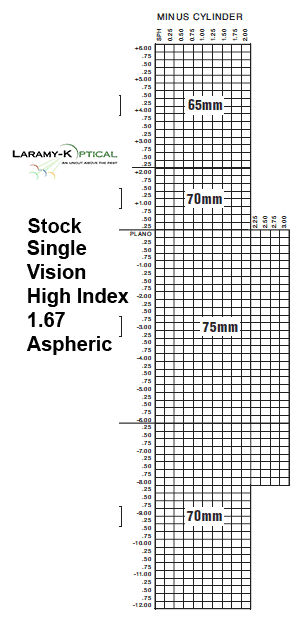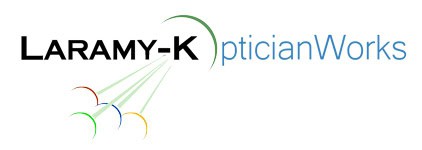Back to: In-House Lens Inventories
This lesson has an individual print-out quiz!
Virtually any shop that has an edger will stock some finished un-cut single vision lenses. You should know by now that you can keep SV lenses in a wide range of sphere and sphere/cylinder powers in stock. Since the lens is round and uncut you will, using the lensmeter, simply rotate and move the lens so the Rx is in the proper place.
You could, in theory, keep lined multifocals and progressives in spherical powers in stock but for many reasons that is never done. Obviously since a lined multifocal has a line you cannot rotate the lens. Since the add power and corridor are molded into a progressive lens it cannot be rotated either. Include the full range of add powers and, well, you get the idea…
Here are just some of the things to think about when considering what lenses to stock:
- Your edger’s capabilities: Older edgers may be set up with a grinding wheel that will only cut some lens materials. Older edgers may also produce inconsistent results in some materials.
- Lens add-ons: If you plan to provide same-day services then you will need the ability to groove lenses for semi-rimless work and be able to provide edge polishing.
- The last quality bench-top groover was made in 1973!
- You can hand polish lenses but risk damaging high cost AR coatings.
- Your customer base: If your practice is primarily aged 55+ you may have very little need for single-vision lenses.
- If you will offer same-day tinting/sunglasses: If your practice caters to a tourist or beach crowd you may want to stock plastic lenses or a true tintable poly so you can tint in-house.
- Will be offering AR coated lenses? If you offer AR coated lenses you will need to double your stock inventory.
- If you will be working with children: If you fill an Rx for a child under 18 you should be putting them in a polycarbonate lens. (Subject to individual law, vision insurance, and your business practices.)
In a small operation with a limited customer base they may stock as few as 120 different powers in pairs for a total of 240 lenses. A larger office with a steady customer base may stock 500 different powers for 1000 lenses.
Plastic (CR-39) and polycarbonate, scratch coated, finished, un-cut lenses wholesale for approximately $3.00 each. This means that a larger store may have a lens inventory worth several thousand dollars. Add in high index lenses, and A/R coated lenses and an inventory may quickly reach the tens of thousands of dollars. Keep in mind that you cannot run what you do not have. But, you also don’t want thousands of dollars of inventory that never sells either.
Finished uncut lenses are available in a very wide range of materials and powers. With overnight shipping it is not uncommon to order a pair of lenses late in the afternoon and have them ready for the patient by late the next morning. Single vision un-cut lenses are available in a set range by each manufacturer. Sphere powers and cylinder powers are both limited by Rx (plus or minus) and by material. You will want the individual lens manufacturer availability charts for the ranges they provide as un-cuts.
They look like something like this:

Things to notice:
- It says Minus Cylinder at the top
- It tells you what lens style (SV & aspheric) and what material (1.67) the chart is for.
- This particular lens is available from +6.00 to -12.00 and out to 2.00 cylinder.
- It is available in 0.00 to -8.00 out to 3.00 cylinder.
- The 65mm, 70mm, 75mm and 70mm is the blank size that you will receive.
As the optician it may be your responsibility to maintain the lens inventory so that you have lenses ready for sale. This may be a little confusing but with practice you will get used to it and be comfortable with it.
Lenses are usually ordered for stock as “half-pairs”. If I need to restock one single finished uncut – 2.00 – 0.50 lens I would order a, “Half pair of – 2.00 – 0.50”. If I need two of the same power I would order it as a pair.
Example: You sold and made four pairs of glasses today. You used the following lenses to fill the orders -0.25 -1.00, – 0.50 -0.50, -0.50 -0.50, -1.00 sph., -2.00 ph., -2.00 sph., -2.00 -0.25, -3.00 -0.75. The call to the lens company for restocking would be, “This is John from 87641 I need to place a stock lens order, poly, no AR, half pair -1.00, pair -0.50 – 0.50, half pair -0.25 – 1.00, pair -2.00, half pair -2.00 -0.25 and half pair -3.00 -0.75.”
Lens packages are usually marked with the Rx in both minus and plus cylinder forms. No axis will be marked since it will be your job to rotate the lens to the proper axis before blocking and cutting it for finishing. Sphere only lenses like a -1.25 Sphere will be marked -1.25 0.00 it WILL NOT say sphere.
A stock range of powers IN PAIRS (CR 39 or Poly) might be:
Plano to – 4.00 spheres
Plano to – 4.00 sphero-cylinders in 0.25 steps up to -1.50 cylinder
Plano to +3.00 spheres
Plano to +3.00 sphero-cylinders in 0.25 steps up to -1.50 cylinder
Lens inventories should be maintained in a logical order. Be sure that drawers or boxes are clearly marked to avoid confusion and restocking mistakes. There may be other ways to do it but everywhere I have worked has used the following method:
0.00 through X.XX spheres 0.00, 0.25, 0.50, 0.75, 1.00 etc.
0.00 with – 0.25 cylinder
0.25 with – 0.25 cylinder
0.50 with – 0.25 cylinder
0.75 with – 0.25 cylinder
1.00 with – 0.25 cylinder etc.
Lens Inventory Quiz
PDF file to download and print.
The Answer Key is below.
Click to Print Lens Inventory Quiz
This is the most thorough inventory you will ever find of everything you might require to have a fully operational in-house lab.
